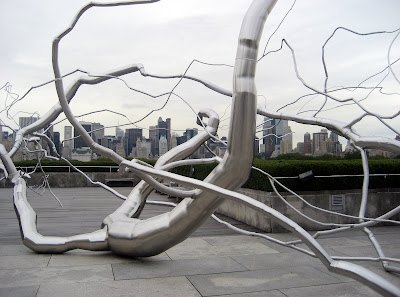
Yes, there are conceptual and formal issues: The systemic quality of the sculpture relates as much to a neural network, or a circulatory sustem, as roots and branches. The branching elements create a fluid script against the sky. Then there’s the lovely incongruity of this “system” of stainless steel pipes set on the edge of arboreal Central Park, which is dense with its own natural ecology. But, really, the best way to experience this work is kinesthetically. Don't think it. Feel it. You can’t climb on it, but you can walk within it and touch it. You can hear it, too.
To orient you as I take you around the roof
. Looking south, the Citicorp building on Lexington Avenue is visible in some of the images. It has what looks like a TV screen set into the topmost part of the facade. The geodesic-paneled column is the new(ish) Hearst tower on 57th Street at 8th Avenue--East Side (left) and West Side (right) respectively
. Looking west across the park, the twin-spired building is the San Remo, one of the great prewar apartment buildings on the West Side. Farther north you'll see another such landmark, the turreted Beresford
. Looking north, there's the visual interruption of the concession stand, though there's also a lovely reflection in the museum’s mirrored windows
. To the east, there's the museum's pergola over which the buildings on Fifth Avenue press too close
We start at the north end of the sculpture looking south.

 .
.
Above: Moving farther into the work. As you look through the sculpture and over the south end of Central Park, you can see the Citicorp and Hearst buildings, respectively left and right in the frame
Below: Within the ticket there's room to move around. While some of the elements are as delicate as tendrils, others are quite a bit larger. I suspect they're helping to hold the massive structure in place.
 .
.
We step back and swing around to the southwest. The sculpture seems to send out runners that insert themselves into the pavement. Yes, it's metal, but it's thrillingly botanical nonetheless. To orient you: The San Remo towers are at the left of the frame, the Beresford turrets, right
.
Below: We move back from the corner of the roof and slightly back toward the south to take in the tuberous node in the bottom right of the frame

.

There are a couple of big nodes, one hiding the other, but you're seeing both, above and below
Below: Possibly my favorite shot, the drama of the ginger-like tuber in the foreground sending out delicate rootlets that seem to slide along the pavement. To orient you, the triangle-facade Hearst building is toward the left, and the San Remo at right, which means we're swinging from southwest to west (again)
 .
.
Continuing our 360-degree tour
Above: we're looking northwest--the San Remo is toward the left of the frame. The calligraphy of the branches against the sky that's so beautiful in the western views of the sculpture changes abruptly as structures to the north and east close in on the work
.
Below: Looking north toward the concession stand
.


.
Northeast view: With the architecture closing in, our view comes closer to the pavement, though there's a lovely touch, below, where a "runner" insinuates itself through the slatted roof of the pergola and into the trees
.
 .
.
.
Above: Bramble-eye view, looking east. See that pair of legs at the far right? We're walking over there next
.
Below: Having walked to the far south end of the roof, we've turned to face north. Before you is an unexpectedly Bourgeoisian element isolated from the main work, though tethered. Formally it may be there just to spatially involve this far end of the roof, but I like the implication that it's new growth, that this sculpture continues to expand before our eyes
.

 Above: Facing north from that far south end
Above: Facing north from that far south end.
Below: Reflecting the south-facing view from the mirrored windows on the roof's north walls. This is the reverse image of where we started our 360 tour
.

.













5 comments:
Kept on marveling at how you took all those photos without people.
Beautiful photos. Thanks for sharing your secret.
I began my viewing of this sculpture well before reading anything in your post and found myself believing that I was looking at a snow covered mangle of a felled tree. Once I had scanned a number of your photos, I realized that it was a metal sculpture and was amazed at how the overcast day had such a 'snowy' effect on the piece. I really like this one.
This has been an enlightening 360 tour.
You captured the rhythm of the limbs beautifully in your photographs, and the work suddenly felt fully alive, with each limb stretching and reaching out to one another as in a graceful ballet.
Interesting posts you have here ... I can see that you put a lot of hard work on your blog. I'm sure I'd visit here more often.
George
from ginseng photos.
Post a Comment